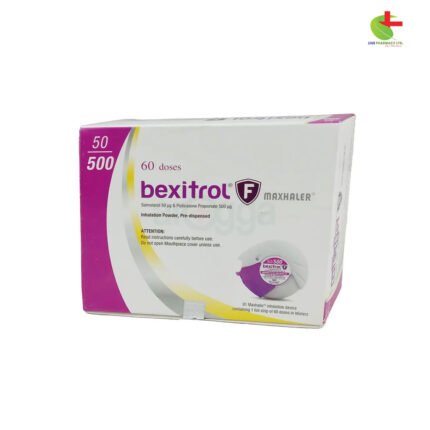Symbion 100
900.00৳ 100mcg+6mcg
- Indications: For asthma management in patients 12 years and older, and maintenance treatment of COPD.
- Description: Combines Formoterol Fumarate and Budesonide for effective bronchodilation and anti-inflammatory action.
- Dosage: Administered via inhaler or inhalation capsule; dosing varies by age and condition.
- Administration: Use as directed, with proper inhaler technique and regular cleaning for optimal results.
 Brand
Brand
|
Beximco Pharmaceuticals Ltd |
|---|---|
 Generics
Generics
|
Budesonide + Formoterol Fumarate |
 Type
Type
|
Maxhaler |
Indications
Asthma Management: This inhaler is prescribed for individuals aged 12 and older for the management of asthma. It is not intended for the relief of acute bronchospasm.
Chronic Obstructive Pulmonary Disease (COPD) Maintenance: This inhalation capsule is designed for the twice-daily maintenance of airflow obstruction in COPD patients, including those with chronic bronchitis and emphysema. It is the sole approved dosage for managing airflow obstruction in COPD.
Description
This inhalation capsule is intended for use with a dry powder inhaler and is for oral inhalation only. It combines Formoterol Fumarate Dihydrate BP and Budesonide BP. Budesonide, a glucocorticosteroid, provides a dose-dependent anti-inflammatory effect when inhaled, reducing symptoms and preventing asthma exacerbations. It generally has fewer adverse effects compared to systemic corticosteroids. The precise mechanism of its anti-inflammatory action is not fully understood.
Formoterol, a selective β2 adrenoceptor agonist, offers rapid and sustained bronchial smooth muscle relaxation in patients with reversible airways obstruction. Its bronchodilating effect starts within 1-3 minutes and lasts for at least 12 hours.
Pharmacology
Budesonide: An anti-inflammatory corticosteroid with significant glucocorticoid activity and minimal mineralocorticoid effects. It inhibits various cell types (e.g., mast cells, eosinophils) and mediators (e.g., histamine) involved in inflammation, contributing to its effectiveness in asthma.
Formoterol Fumarate Dihydrate: A long-acting β2-adrenergic agonist with rapid onset. It acts locally in the lungs to relax bronchial smooth muscle by increasing cyclic AMP levels through stimulation of adenyl cyclase, which also inhibits the release of hypersensitivity mediators.
Dosage
Inhaler (For Asthma):
- Adults and Adolescents (12 years and older): The standard maintenance dose is 1 puff twice daily or 2 puffs once daily. A 2-puff twice-daily dose may be suitable for some patients (160/4.5 mcg/inhalation only). An additional puff may be taken as needed. Do not exceed 6 puffs in a single occasion.
- Children: Typically, 1-2 puffs once or twice daily. An additional puff may be used as needed. Do not exceed 4 puffs in a single occasion.
Inhalation Capsule (For Asthma):
- Adults and Adolescents (12 years and older):
- Maintenance: 100 or 200 Inhalation Capsules twice daily.
- Reliever: 1 additional Inhalation Capsule as needed. Up to 12 capsules daily can be used temporarily.
- Children (4 years and older):
- Maintenance: 100 Inhalation Capsule once daily.
- Reliever: 1 additional Inhalation Capsule as needed. Up to 8 capsules daily can be used temporarily.
Inhalation Capsule (For COPD):
- Adults (40 years and older):
- 200 Inhalation Capsule: 2 capsules twice daily (maximum of 4 capsules daily).
- 400 Inhalation Capsule: 1 capsule twice daily (maximum of 2 capsules daily).
Use as directed by your healthcare provider.
Administration
Proper inhaler use is crucial for effective medication delivery. Incorrect use may reduce medicine reaching the lungs. Follow these steps for optimal use:
- Remove the cap.
- Shake the inhaler vigorously for at least six times.
- If the inhaler is new or unused for a week, shake it well and release one puff into the air.
- Exhale fully, hold the inhaler upright.
- Place the actuator between your teeth and close lips around the mouthpiece.
- Inhale deeply and slowly through your mouth while pressing down on the canister to release the medication.
- Remove the inhaler from your mouth and hold your breath for at least 10 seconds.
- If more puffs are prescribed, wait 1 minute between doses and repeat the steps.
- After use, replace the cap and rinse your mouth with water.
- Regularly check your technique and clean the inhaler weekly as follows:
- Remove the canister and rinse the actuator and cap in warm water (do not immerse the metal canister).
- Dry thoroughly before reassembling.
Interactions
Avoid using with strong cytochrome P450 3A4 inhibitors (e.g., ritonavir) due to increased systemic corticosteroid effects. Caution is advised when combined with Monoamine oxidase inhibitors, tricyclic antidepressants, and beta-blockers. Use cautiously with diuretics to prevent potential side effects.
Contraindications
Not suitable for:
- Primary treatment of status asthmaticus or acute asthma/COPD episodes requiring intensive measures.
- Patients with hypersensitivity to any ingredient in this medication.
Side Effects
Formoterol Fumarate: Commonly causes tremor, palpitations, and headache. Rarely, cardiac arrhythmias, muscle cramps, and hypersensitivity reactions may occur.
Budesonide: May cause hoarseness, throat irritation, candida infections, and, rarely, cutaneous hypersensitivity reactions, respiratory infections, and growth effects in children.
Pregnancy & Lactation
Limited data is available on the use of this combination during pregnancy. Budesonide is excreted in breast milk, but adverse effects on nursing infants are unlikely. Formoterol may also pass into breast milk in small amounts.
Precautions & Warnings
Use with caution in patients with diabetes, cardiovascular disorders, glaucoma, or those at risk of paradoxical bronchospasm. Discontinue if paradoxical bronchospasm occurs.
Use in Special Populations
Monitor the growth of children on prolonged inhaled corticosteroid therapy. Adjust therapy as needed and consider referral to a pediatric respiratory specialist.
Overdose Effects
Symptoms of Formoterol overdose may include tremor, headache, palpitations, tachycardia, hyperglycemia, and hypokalaemia. Acute overdose of Budesonide is generally not a clinical concern, though long-term excessive use can lead to systemic effects.
Storage Conditions
Do not swallow inhalation capsules. Store at or below 25°C, away from light and moisture. Keep out of reach of children. Only remove capsules from blister packs immediately before use.













Reviews
There are no reviews yet.